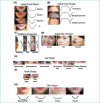A New Simplified Visual Assessment Tool Describing Facial Morphotypes Observed and Desired in Asian Populations
- PMID: 33144908
- PMCID: PMC7605391
A New Simplified Visual Assessment Tool Describing Facial Morphotypes Observed and Desired in Asian Populations
Abstract
OBJECTIVE: A group of established aesthetic physicians sought to develop treatment guidelines for assessing Asian face morphologies that reflect accurate and current beauty standards across Asia. DESIGN: Physicians completed surveys, debated, and voted on their clinical strategies and developed an alternative simplified visual tool of assessment (SVAT) that discerns between country variations in genetic and ideal morphotypes. SETTING: Electronic and paper surveys were followed by consensus debates and voting. PARTICIPANTS: Established aesthetic physicians practicing regularly on Asian patients. MEAUSUREMENTS: A clinically applicable SVAT was developed, which considered facial index, mid-face projection, upper and lower face shape, submalar contour, nose length and dorsal height, eye shape and brow shape, proportion of lips-to-lower face and ratio of upper-to-lower lip, and chin shape. RESULTS: For facial shape change, physicians always assessed the horizontal thirds, facial symmetry, and lip-chin complex profile, and also analyzed overall face shapes and Ogee curves. Criteria for creating oval-shaped faces was also defined and included treating indications, such as loss of angularity and bilateral masseter muscle hypertrophy, narrow jawlines, and longer and wider foreheads. Critical differences and similarities in country-specific aesthetic preferences, treatment requests, and considerations or strategies were uncovered, including the inadequacy of assessing overall peripheral facial shapes. CONCLUSION: This consensus establishes the assessment and treatment criteria for achieving ideal shapes for Asian patients. Specific descriptors are affected by variations; therefore, we present the visual criteria for Asian facial morphotypes. We hope that physicians new to treating Asian patients can use this clinical information to improve their practice.
Keywords: Asian; Face shape; aesthetic medicine; anthropometric; treatment strategy.
Copyright © 2020. Matrix Medical Communications. All rights reserved.
Conflict of interest statement
FUNDING:No funding was provided for this study. DISCLOSURES:Merz Asia Pacific, Pte. Ltd. sponsored the preparation of this manuscript and the article processing charge. Niamh Corduff is a consultant for Merz Asia Pacific and Australia. Adri Prasetyo is a consultant for Merz Asia Pacific. All other physicians report no relevant conflicts of interest.
Figures













References
-
- Anic-Milosevic S, Mestrovic S, Prlic A et al. Proportions in the upper lip-lower lip-chin area of the lower face as determined by photogrammetric method. J Craniomaxillofac Surg. 2010;38:90e95. - PubMed
-
- Hanihara T. Frontal and facial flatness of major human populations. Am J Phys Anthropol. 2000;111(1):105–134. Jan. - PubMed
-
- Lee C. Asian Malar and Mandibular Surgery: Background, History of the Procedure, Problem. https://emedicine.medscape.com/article/1280538-overview Medscape site. 26 Oct 2018. 7 Apr 2020.
LinkOut - more resources
Full Text Sources
